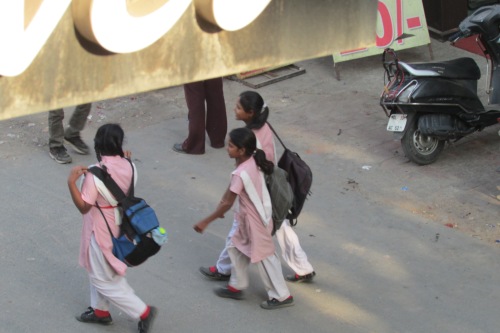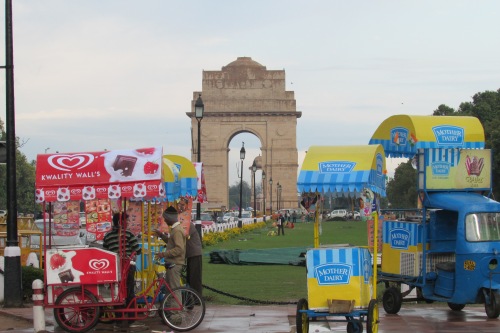It’s a travel week here on the blog (travel posts go up on alternate Wednesdays, in case you haven’t noticed), and this week I’m going back to telling tales from the road.
The third country on our grand adventure was India. After whirlwind tours of Malaysia and Thailand, we were looking forward to getting to know this country better — we had a full six weeks there, which sounded like a long time (ha). Our loose plans included a mixture of touristic itineraries and visiting my travelling companion’s relatives.
Our initial impressions of India were fourfold.
Poverty

These carts are ubiquitous in Delhi.
We were picked up at the Delhi airport by a relative…and his driver. Having household help (driving, laundry, dishes) is common among the Indian middle class, but we never felt quite comfortable with the idea. It underscored the depth and breadth of poverty in the country.
In fact, poverty was our first impression. The grassy medians near the New Delhi airport had people using them as a park, a place to stroll or play ball or take a nap. A little later on, I realized that some people were actually living by the road — in cobbled-together hovels, in makeshift tents, or just on the bare sidewalk. At stoplights we were harassed by people selling trinkets, everything from balloons to hunks of fruit.

Old Delhi bazaar
I had known that about India, had been prepared to see it, but actually experiencing it was still hard to take.
(I’ve mentioned before that I’m not comfortable snapping away at the poorest of the poor — after all, I’m not a journalist, just a tourist. So I don’t have pictures of the worst of it.)
Chaos
 Our second impression was one of chaos. The roadsides were full of garbage and dirt. Buildings and fences were jumbled, unplanned, lacking in upkeep.
Our second impression was one of chaos. The roadsides were full of garbage and dirt. Buildings and fences were jumbled, unplanned, lacking in upkeep.
Driving was…well, loud, because everyone honked constantly. We eventually came to realize that there is some method it. You honk when you’re passing or when you want to pass. You honk when somebody ahead of you is in a slower vehicle. You honk when you’re driving past a pedestrian who’s trying to cross. You honk when somebody does something unexpected. You honk when there’s a traffic jam. And so on.

Lane markings are treated like suggestions — if you can squeeze in to create a third lane, why not? A lot of the traffic is motorcycles, motor scooters, auto-rickshaws (think golf carts), and cycle-rickshaws (bikes with a two-seater passenger cart on the back), all of which weave in and out with abandon. And there are almost no traffic lights, only roundabouts. Yet we saw very few accidents. We finally concluded that every vehicle is surrounded by an invisible bubble. Or, to put it another way, driving in India is a form of haggling.
Modernity

A trio of friends with overloaded backpacks…look familiar?
Our third impression took a little longer to form. We visited a call centre that looked clean and modern, resembling a cubicle farm in any Western office tower rather than a sweatshop factory; the manager spoke good English and we found him surprisingly easy to talk to. Then we met our hosts’ adult daughter, an independent-minded woman who is married and has a daughter of her own, but who also works outside the home and drives her own scooter.
People like these are the face of urban, middle-class India…which is far from the only India, but it’s one that doesn’t get shown much in Western media. We hear about the discrimination, the poverty, the misogyny (more about that another time) — all at shocking levels to Western eyes — and those are all very much true. But they’re not the only truth.
Contrasts

The Rajpath, a grand boulevard built by the British, now used as a park and a place to stroll.
For our initial shopping experience in India, we went to Palika Bazaar, a cramped, subterranean shopping mall jam-packed with tiny stores. There we got mobbed from all sides as the salesmen smelled green tourists and tried to wave their wares in our faces. My travelling partner practised his haggling skills and bought sunglasses (for way too many rupees) and a sweater (for what in Canada would be a pretty good deal). We emerged weary but wiser. +1 on the experience points!
But India is changing fast, and this was brought home when our host told his driver to take us to a “nice mall”. This turned out to mean a shiny new Western-style mall, full of upscale chains like Guess. Not quite the shopping experience we had in mind! We could have been anywhere in North America.
The only jarring bit was the security checkpoint, thanks to bombings of malls in the past. Nobody was allowed in without going through a scanner, being patted down (always separated by gender — a conservative touch, but a nice one), and having their bags poked through. This was an odd experience, and one we never really got used to.

In the end, our strongest impression was one of contrasts. Delhi is a city of wearying sales pressures — it sees a lot of fresh tourists and isn’t shy about taking advantage of them. But it’s also a vibrant city, full of life and colour, a vivid feast for the senses in a way that quiet Canadian cities just aren’t. And the poverty and chaos exist side by side with the modernity — from the cutthroat bargaining in Palika Bazaar to brand-name clothing stores and Western-style coffee chains in Connaught Place just a few steps away.
Your turn! What are your impressions of India?
















